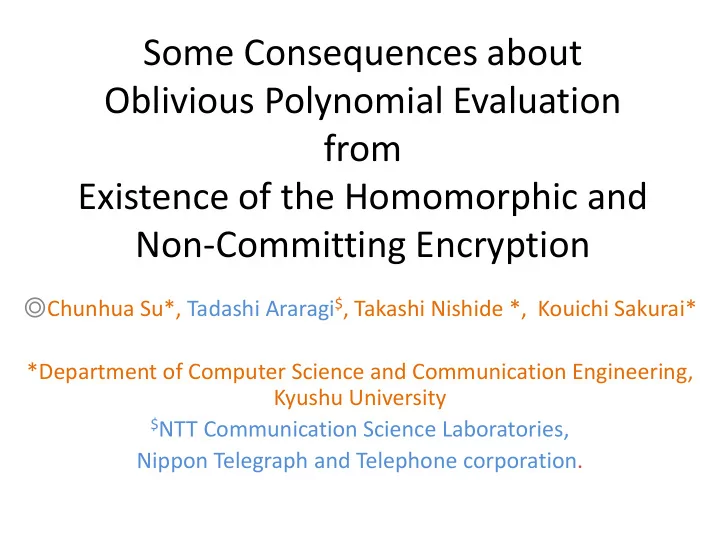

Some Consequences about Oblivious Polynomial Evaluation from Existence of the Homomorphic and Non ‐ Committing Encryption ◎ Chunhua Su*, Tadashi Araragi $ , Takashi Nishide *, Kouichi Sakurai* *Department of Computer Science and Communication Engineering, Kyushu University $ NTT Communication Science Laboratories, Nippon Telegraph and Telephone corporation.
1. OPE from Homomorphic Encryption R S w P(x) = Σ a i x i P(w) An efficient example of OPE: The Receiver The Sender The receiver finally get the Generate the keys of Generate a polynomial homomorphic encryption and the value w Our goal: UC secure against malicious and adaptive adversary The Problem: How to simulate the adaptive corruption? 2
2. Universal Composability and Adaptive Corruption 1. The environment can not distinguish the outputs from real world and ideal world. 2. Adaptive corruption: occur at any stage during the protocol execution. Environment Z Environment Z ‐ eardrop ‐ temper ∃ Get the input ∀ ‐ interrupt and out of the Simulator Adversary corrupted party Protocol Execution Functionality ( TTP ) Real World Ideal World 3
An Open Problem Three conditions must be satisfied for an adaptively and UC secure OPE : (1)Simulation Extractability: the simulator can extract the contents of any valid commitment/encryption generated by the adversary. Functionality Extracted input w Same output as in real protocol execution P(w) Simulator Environment (2) Equivocality: simulator can generate some ”fake” ciphertexts that can later be explained as encryptions of anything. An Encryption of input “eqe” I have received the plaintext “w” from the adversary of real world! Simulator What I have sent to you is an Encryption of “w”! Environment Now I am going to show you….
Cont’d (3) Homomorhpic Encryption: E(a; r 1 ) E(b; r 2 )=E(a+b; R 1 +R 2 ) � Non ‐ committing encryption is a good candidate which can satisfies condition (1) and (2), but does not satisfy (3). � Can we find a non ‐ committing encryption with homomorphism?
A hint? • Boneh et al. [BBS04]’s encryption scheme based on Decisional Linear DH Assumption: • Public key: f, h, g ; Secret key: x, y so f = g x , h= g y • Encrypt message m: (u, v, w) = (f r , h s , g r+s m) • Decrypt (u,v,w): m = w u ‐ 1/x v ‐ 1/y Easy to get the equivocality and homomorphism with some modification, but diffcult to get the extractability [BBS04] D. Boneh, X. Boyen, and H. Shacham. “Short group signatures”. CRYPTO04, volume 3152 of LNCS, pp. 41–55. Springer, 2004.
Recommend
More recommend